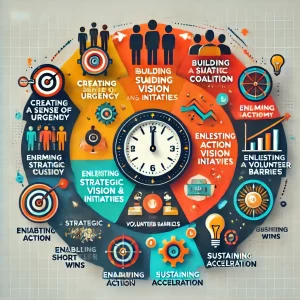A Blueprint for Organizational Change
 When writing or speaking on business and technology topics, I often talk about creating and supporting a culture of change, and how organizations that excel at recognizing and adapting to change will have a distinct competitive advantage over those who do not. Organizations must be agile and adaptable to stay competitive. Implementing change, however, is often met with resistance and complexity. The 8-Step Model for Leading Change offers a systematic approach to successfully navigate organizational change. I’ve mentioned this several times in previous posts, but thought I would share some additional detail. This model provides a clear framework that guides leaders through the transformation process, ensuring sustainable and impactful results.
When writing or speaking on business and technology topics, I often talk about creating and supporting a culture of change, and how organizations that excel at recognizing and adapting to change will have a distinct competitive advantage over those who do not. Organizations must be agile and adaptable to stay competitive. Implementing change, however, is often met with resistance and complexity. The 8-Step Model for Leading Change offers a systematic approach to successfully navigate organizational change. I’ve mentioned this several times in previous posts, but thought I would share some additional detail. This model provides a clear framework that guides leaders through the transformation process, ensuring sustainable and impactful results.
Understanding Kotter’s 8-Step Model
Developed by Harvard Business School Professor John Kotter, this model outlines eight essential steps for effective change management. Each step builds upon the previous one, creating a cohesive strategy that drives transformation from conception to execution.
- Creating a Sense of Urgency. Change begins with a compelling reason. Leaders must identify potential threats and opportunities to highlight why change is necessary. Creating urgency motivates stakeholders to take immediate action and helps overcome complacency.
- Building a Guiding Coalition. Successful change requires collaboration. Forming a diverse, influential team with the authority and energy to drive change ensures collective ownership and accountability. This coalition advocates for the change and helps align the organization around the transformation goals.
- Forming a Strategic Vision and Initiatives. A clear vision provides direction. Leaders need to articulate a strategic vision and develop initiatives that align with organizational goals. This vision serves as a roadmap, guiding decision-making and resource allocation throughout the change process.
- Enlisting a Volunteer Army. Change thrives when more people are engaged. By inspiring and empowering employees at all levels, leaders can build a volunteer army that actively participates in driving change. Broad-based support accelerates momentum and fosters a culture of innovation.
- Enabling Action by Removing Barriers. Obstacles hinder progress. Leaders must identify and eliminate barriers—whether structural, procedural, or cultural—that prevent people from taking action. Providing resources, streamlining processes, and addressing resistance empower teams to move forward confidently.
- Generating Short-Term Wins. Quick wins validate the change effort. Achieving and celebrating small, visible successes builds credibility and motivates continued effort. These early victories demonstrate progress and help sustain engagement across the organization.
- Sustaining Acceleration. Momentum must be maintained. Leaders should use the credibility gained from short-term wins to tackle larger challenges and drive deeper change. Continuous improvement and reinforcement ensure that change initiatives do not lose steam.
- Instituting Change. For change to stick, it must become part of the organizational culture. Embedding new behaviors, processes, and values into everyday operations ensures long-term sustainability. Recognizing and rewarding behaviors that support the change solidify its place within the organization.
Why Organizations Should Use Kotter’s 8-Step Model
Implementing change without a structured approach can lead to confusion, resistance, and failure. Kotter’s model mitigates these risks by providing a step-by-step guide that engages employees, aligns efforts, and fosters accountability. Organizations that follow this model benefit from:
- Clear Direction: A well-defined vision and strategic initiatives guide decision-making.
- Employee Engagement: Broad-based involvement increases buy-in and reduces resistance.
- Sustainable Results: Embedding change into the culture ensures long-term success.
- Continuous Momentum: Short-term wins and sustained acceleration keep progress moving forward.
Integrating Kotter’s Model into Broader Change Management Strategies
Kotter’s 8-Step Model complements other change management frameworks, such as ADKAR and Lewin’s Change Model, by providing actionable steps for leading change. It can be integrated with project management methodologies and organizational development strategies to ensure a comprehensive approach to transformation.
For example, organizations can align Kotter’s model with agile practices by fostering collaboration and delivering incremental improvements. Combining this model with tools like stakeholder analysis, communication planning, and performance metrics enhances its effectiveness and ensures alignment with broader strategic goals.
Change is inevitable, but successful change requires intentional effort. Kotter’s 8-Step Model offers a proven framework for leading organizational transformation. By following these eight steps, leaders can create urgency, build support, remove obstacles, and embed change into the culture, driving sustainable growth and innovation. Embracing this model empowers organizations to navigate change with confidence, and, if they make it part of their ongoing organizational culture, they can achieve lasting success.




